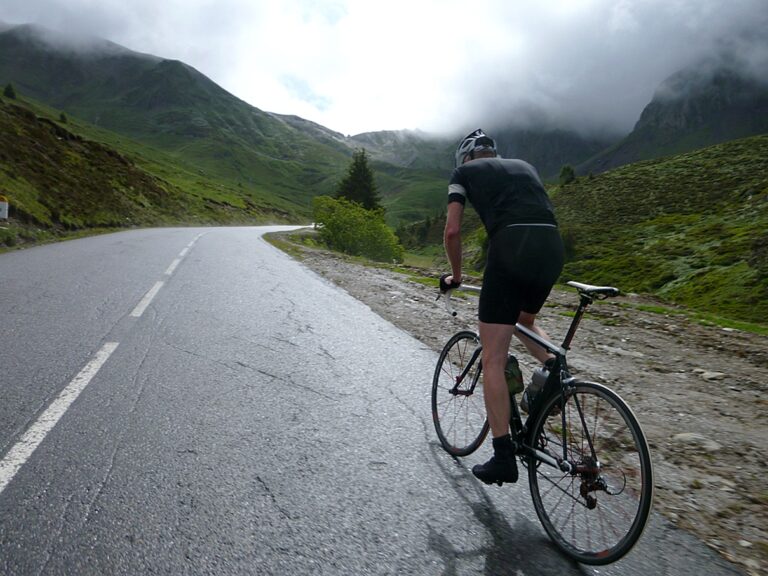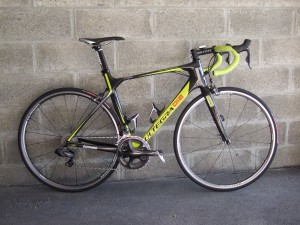 Overview
Overview
Let’s get one thing straight right away; Shimano’s new Ultegra-level version of the Di2 electronic derailleur shifting system works, and beautifully. In other words, it shifts from one sprocket or chainring to another on request quickly, accurately and, importantly, reliably.
Reliably as in it does what it is required to do time after time after time – at least until the battery runs down. And how long does the battery last? Exactly the same component as used in the now-proven Dura-Ace Di2 group, which made a near clean sweep of the major prizes in the 2011 Tour de France, the lithium-ion battery is rated for at least 1,000 km of riding per charge and can last several times as far depending, naturally enough, on the number or frequency of gear changes made per km (or mile even…). It is also guaranteed by Shimano to accept at least 500 recharges, which means that any young cyclist buying Di2 and hoping one day to gain admittance to the 300,000 mile club can expect his or her battery at least to be going strong on the glorious day of qualification.
 To keep track of battery charge level there’s a neat little indicator that sits zip-tied to one of the brake cables just below the handlebars; full, half and quarter-charge levels are indicated with a countdown from quarter to empty that should give enough time to get the battery recharged before it’s too late. And what happens when the battery runs flat? First to stop working is the front shifter, which takes the most power to operate. And stop shifting is what it does, simply remaining in which of the two chainrings it was in when sufficient power ran out. Same at the back; the mech eventually stops moving and that’s the gear you are in until the battery is recharged.
To keep track of battery charge level there’s a neat little indicator that sits zip-tied to one of the brake cables just below the handlebars; full, half and quarter-charge levels are indicated with a countdown from quarter to empty that should give enough time to get the battery recharged before it’s too late. And what happens when the battery runs flat? First to stop working is the front shifter, which takes the most power to operate. And stop shifting is what it does, simply remaining in which of the two chainrings it was in when sufficient power ran out. Same at the back; the mech eventually stops moving and that’s the gear you are in until the battery is recharged.
So, now that’s out of the way… The system on the bike comprises the dual-control levers familiar to users of STI shifting, electronically-operated front and rear derailleurs, a battery and electric cables complete with the charge indicator. There is, of course, a charger for the battery and there is, apparently software on the way – maybe in time for the start of series manufacture – that allows the Di2 controller to interact with the owner’s computer for diagnostics and to alter “shift direction”…
 The kit includes grommets of two sizes to fit holes in frames made for either Dura-Ace or Ultegra Di2 and the wires have short Nylon zip ties – which aren’t, as they attach via a C-clip – set along their length to prevent rattling when installed in a frame tube. The remaining Ultegra components: Hollowtech II crankset, brake calipers, cassette and chain, are taken from the 6700 group. Weight, depending on stuff such as cable length, is around 90g heavier than Ultegra 6700.
The kit includes grommets of two sizes to fit holes in frames made for either Dura-Ace or Ultegra Di2 and the wires have short Nylon zip ties – which aren’t, as they attach via a C-clip – set along their length to prevent rattling when installed in a frame tube. The remaining Ultegra components: Hollowtech II crankset, brake calipers, cassette and chain, are taken from the 6700 group. Weight, depending on stuff such as cable length, is around 90g heavier than Ultegra 6700.
Both front and rear mechs operate along conventional lines, at least in terms of how they move the chain across rings and sprockets. The latter uses the familiar deformable parallelogram to move its two jockey wheels and cage laterally, with chain tension taken care of by the usual two sprung pivots. At the front, the plates of the moveable cage look pretty much as they do in a cable-operated mech and the same deformable parallelogram design controls its motion path.
The two mechs’ sheer size is the most obvious visual identifier of Di2; each mech features a large grey plastic case housing its servo-motor and controlling electronics. The front mech has a self-trim function that ensures the side plates don’t rub on the chain even when it is running large chainring/large sprocket. The rear mech simply shifts its cage a precise lateral distance each way, with no chain line trim taking place once initial set up is complete. One point of difference with Dura-Ace Di2 is the greater precision of adjustment possible with Ultegra, which has 30 possible trim positions for the jockey wheel alignment available on initial installation – 15 either side of “centre” – rather than the 24 of Dura-Ace.
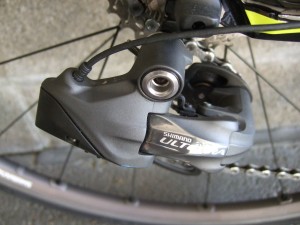 Riding Ultegra Di2
Riding Ultegra Di2
Each of the journos attending the press camp at Aigle in Switzerland, home of cycle racing’s governing body, the UCI, got to ride a non-badged but readily-identifiable 2012 Giant Defy Advanced SL equipped with Di2 and Shimano Ultegra or Dura-Ace wheels plus PRO cockpit and saddle/seatpost.
The bikes were pretty much ready to roll, needing only adjustment for riding position, so there was no chance to see the components being installed or even receiving final adjustment. We were told that these were strictly prototype parts that, while operational, might not be exactly as full production examples. Apparently the only issue yet to be finalised is the design of the wiring connectors, which will be waterproof but aren’t quite so just yet. The reason is that Shimano made a number of prototype groupsets at the request of cycle manufacturers wanting working samples during summer 2011 and had not had time to finalise this critical part of the design.
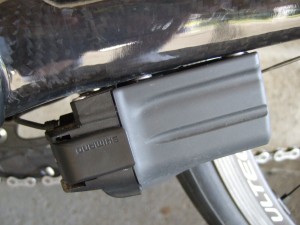 As it happens, one of the press bikes’ Di2 did stop working briefly when it got wet near the top of a climb outside Monthey, getting stuck in 39×28. None of the other machines was affected. One improvement over Dura-Ace promised by the Ultegra version is ease of installation. The 5.1mm diameter Ultegra connectors – 3.7mm smaller than Dura-Ace – have just two inner wires instead of four, the system operating via CANbus communication, and will be “plug-and-go” unlike the Dura-Ace connectors, which need to be made waterproof using heat-shrink tubing following installation.
As it happens, one of the press bikes’ Di2 did stop working briefly when it got wet near the top of a climb outside Monthey, getting stuck in 39×28. None of the other machines was affected. One improvement over Dura-Ace promised by the Ultegra version is ease of installation. The 5.1mm diameter Ultegra connectors – 3.7mm smaller than Dura-Ace – have just two inner wires instead of four, the system operating via CANbus communication, and will be “plug-and-go” unlike the Dura-Ace connectors, which need to be made waterproof using heat-shrink tubing following installation.
Those who have ridden the Dura-Ace version will have a very good idea what to expect from Ultegra Di2. For those who haven’t, it is only really noticeable when effecting a shift. Obviously. That said, the hoods have a textured surface and sharper shape than mechanical Ultegra and the absence of the shift machinery and accompanying gap in the hood rubbers just behind and inboard of the levers offers a different grip sensation.
Brake operation is indistinguishable, with power and modulation both easily up to any situation we experienced including the stunning descent back to Aigle from the Lac de l’Hongrin military road above Luan.
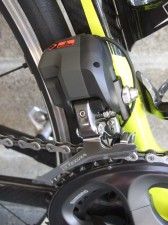 So, shifting is where the action is. And, as already stated, it works – surely even better than mechanical Ultegra save for the fact that shifting is one gear at a time. At the touch of either button, the front mech will shift the chain even under severe load and, having done so from small to big rings, will then of its own volition trim the cage to perfection. Rear shifts are fast enough to require the occasional glance down to see if anything has happened. ‘Cos sometimes it hasn’t. Both the rear paddle and the dimpled button on the brake lever require more than just a faint touch – just as well given the speed of shift – and on several occasions I found myself having to press the relevant part a second time – and harder – to get the gear I wanted.
So, shifting is where the action is. And, as already stated, it works – surely even better than mechanical Ultegra save for the fact that shifting is one gear at a time. At the touch of either button, the front mech will shift the chain even under severe load and, having done so from small to big rings, will then of its own volition trim the cage to perfection. Rear shifts are fast enough to require the occasional glance down to see if anything has happened. ‘Cos sometimes it hasn’t. Both the rear paddle and the dimpled button on the brake lever require more than just a faint touch – just as well given the speed of shift – and on several occasions I found myself having to press the relevant part a second time – and harder – to get the gear I wanted.
This, of course, is precisely what getting accustomed to the system will be all about for those who buy it. By the end of the third ride of the camp I was fully up to speed, as it were, with gear shifting, getting at least 99percent right first time. Those I did not were invariably due to pressing the paddle when I wanted the button – which meant, if I was operating the right-hand lever, getting an upshift when I wanted the opposite.
Here lies my only query regarding the entire system. Presumably wanting to mimic the functionality of mechanical STI, which uses the brake lever to shift one way and the paddle behind it to shift the other, Shimano’s engineers opted for a paddle to operate the switch making the mech shift in one direction – and a button on the brake lever to shift the other. Initially, unless I thought about what I was doing – an admittedly rare occurrence when shifting – I found the fact that the Di2 brake lever does not move sideways confusing, offering as it does something of the touch sensation of dual control levers by competing manufacturers.
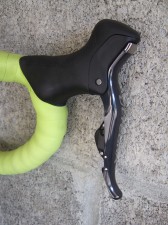 But that’s just me… And I was well on the way to overcoming my own limitations by the end of the camp. As for those of Ultegra Di2, it’s hard to see what, apart from the small risk of a flat battery, they might be. One of the Shimano mechs from the US pointed out that a Dura-Ace Di2-equipped ‘cross bike he’d built for the 2010/11 season continued working flawlessly through the worst of that winter’s conditions where the control cables of mechanically-shifting bikes needed regular maintenance. But the slender wires do look a little vulnerable to snagging.
But that’s just me… And I was well on the way to overcoming my own limitations by the end of the camp. As for those of Ultegra Di2, it’s hard to see what, apart from the small risk of a flat battery, they might be. One of the Shimano mechs from the US pointed out that a Dura-Ace Di2-equipped ‘cross bike he’d built for the 2010/11 season continued working flawlessly through the worst of that winter’s conditions where the control cables of mechanically-shifting bikes needed regular maintenance. But the slender wires do look a little vulnerable to snagging.
Winter commuting – that’s where Ultegra Di2 shifting will really pay off. Provided the bike can be locked away safely during the day.
Available September 2011.





